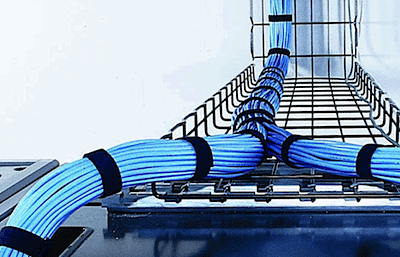Published: 11 March 2014
Category: Q&A
James asks this question, which concerns the cleating of cables on horizontal cable ladder systems, and the necessity – or otherwise – for it. It has been answered by both Cablofil and the NICEIC (Theme – Distribution Equipment including Cable Management):

This Q & A is one of thousands posted in our Technical Expertise area, and answered on a daily basis by our Voltimum Experts.
Question: We have just had two parallel 185mm x four-core armoured cables installed on a ladder system. The vertical section has been cleated - as I would expect - but the horizontal has not been cleated or tied at all and is just laid upon the ladder.
I appreciate that the ladder is taking the weight of the cables and so therefore they are supported, but I’m of the understanding that in the event of a short circuit or cable fault, the cable would jump and snake about. Therefore, to be truly sufficiently supported, these cables would need to be cleated on the horizontal also. Am I right?
I’ve looked for guidance on cleating / supporting cables to ladder / cable tray, but cannot find any information for a cable of this size.
So, firstly... am I correct in my thinking that the cables need cleating on the horizontal?
Secondly... can you give me some advice and guidance, or point me in the right direction as to where I find information about distances between cleats?
Any information would be very appreciated.
Cablofil Answer: You are correct. Cabling should always be fastened to the cable ladder (or cable tray) using cleats or cable ties to prevent movement of the cables under normal use and during fault conditions.
Generally the spacing between cable fastenings should not exceed the dimensions stated in the On Site Guide to BS 7671:2008. Cable cleats and ties should be correctly sized and only tightened enough to secure the cable without indenting the insulation sheath. Where possible, it is best practice to position cleats on alternate rungs of the cable ladder in order to evenly spread the load along its length.
When an electrical short circuit occurs under fault conditions, the current that flows can produce large mechanical forces that can cause significant displacement of the cables. Therefore some form of restraint must be provided to prevent damage to them. When the cables are cleated to the cable ladder, some of this force may be transferred to the cable ladder via the cleat and it is possible that this force may be sufficient to cause damage to the ladder or tray.
In your instance, 185mm2 x four-core cable is outside of the scope covered by BS 7671. You will need to contact the manufacturer of the cables themselves and seek their recommendation.
For more information on 'best practice' including full details of the subject covered above, download The BEAMA Best Practice Guide from the following link: http://www.legrand.co.uk/display-downloads/3
NICEIC Answer: All cables must be supported throughout the length of the cable to reduce any stress that may cause deterioration of the cable that could result in a compromise in its electrical safety.
Table D1 page 129 gives maximum spacings of cable supports in your On Site Guide. By using the information, you would then meet the requirements of Regulation 522.8 of your current BS 7671:2008 (2011).
In terms of other mechanical stresses, as always, the larger the cable, the more support will be required to retain it in a safe manner.
To see many more Q & A in Voltimum UK's Experts Area, please click on the link. Experts from leading organisations provide online answers to your technical questions on a broad range of subjects. Our searchable database of existing Q & As now contains over 3,500 entries; you can browse through them here.
